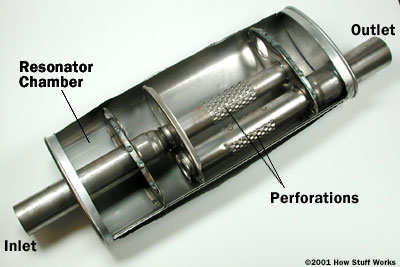Difference between revisions of "muffler"
(Created page with " <!-- Start of Comments this information is to help the person collaborating on the Wiki Page Terminology Template--> <!--Copy all of the information on this page and paste...") |
|||
| (One intermediate revision by the same user not shown) | |||
| Line 1: | Line 1: | ||
| − | + | {{Template:TopWiki}} <!-- Do not remove this line --> | |
| − | + | [[File:Muffler-cutopen.jpg|400px|center]] | |
| − | + | ==Definition== | |
| − | |||
| − | |||
| − | |||
| − | |||
| − | |||
| − | |||
| − | |||
| − | + | A muffler is a device for reducing the noise emitted by the [[exhaust]] of an [[internal combustion engine]]. This noise deadening device is especially one forming part of the exhaust system of an automotive vehicle. | |
| − | |||
| − | |||
| − | |||
| − | |||
| − | + | Mufflers are installed within the exhaust system of most internal combustion engines. The muffler is engineered as an acoustic device to reduce the loudness of the sound pressure created by the engine by acoustic quieting. The noise of the burning-hot exhaust gas exiting the engine at high speed is abated by a series of passages and chambers lined with roving fiberglass insulation and/or resonating chambers harmonically tuned to cause destructive interference, wherein opposite sound waves cancel each other out.[citation needed] | |
| − | + | An unavoidable side effect of this noise reduction is restriction of the exhaust gas flow, which creates [[back pressure]], which can decrease engine efficiency. This is because the engine exhaust must share the same complex exit pathway built inside the muffler as the sound pressure that the muffler is designed to mitigate. | |
| − | + | Some aftermarket mufflers claim to increase engine output and/or reduce fuel consumption by slightly reduced back pressure. This usually entails less noise reduction (i.e., more noise). | |
{{Template:BottomWiki}} <!-- Do not remove this line --> | {{Template:BottomWiki}} <!-- Do not remove this line --> | ||
== [[References]] == | == [[References]] == | ||
| − | + | * https://en.wikipedia.org/wiki/Muffler | |
* <!-- List references, starting with * --> | * <!-- List references, starting with * --> | ||
| Line 32: | Line 21: | ||
Change the Category below to the appropriate category(s). In the special pages you will find a link to the list of categories. | Change the Category below to the appropriate category(s). In the special pages you will find a link to the list of categories. | ||
| − | [[Category:Terminology]] <!-- Leave this line or change to the proper approved category --> | + | [[Category:Terminology]] <!-- Leave this line or change to the proper approved category -->[[Category:Under Construction]] |
| − | [[Category:Under Construction]] | ||
[[Category:Parts]] | [[Category:Parts]] | ||
Latest revision as of 04:58, 29 April 2020
Definition
A muffler is a device for reducing the noise emitted by the exhaust of an internal combustion engine. This noise deadening device is especially one forming part of the exhaust system of an automotive vehicle.
Mufflers are installed within the exhaust system of most internal combustion engines. The muffler is engineered as an acoustic device to reduce the loudness of the sound pressure created by the engine by acoustic quieting. The noise of the burning-hot exhaust gas exiting the engine at high speed is abated by a series of passages and chambers lined with roving fiberglass insulation and/or resonating chambers harmonically tuned to cause destructive interference, wherein opposite sound waves cancel each other out.[citation needed]
An unavoidable side effect of this noise reduction is restriction of the exhaust gas flow, which creates back pressure, which can decrease engine efficiency. This is because the engine exhaust must share the same complex exit pathway built inside the muffler as the sound pressure that the muffler is designed to mitigate.
Some aftermarket mufflers claim to increase engine output and/or reduce fuel consumption by slightly reduced back pressure. This usually entails less noise reduction (i.e., more noise).
Random Page | Longest Wikis | Oldest Wikis | Newest Images | Newest Wikis | List of Categories | List of Every Freakin Wiki
- Register to Edit
- It takes less than 5 minutes to request registration for editing, and we try to approve within 24 hours. Click the Register Link in the Top Bar.
- MoparWiki Help
- While editing Wikis may at first glance appear a little overwhelming, it really isn't. You will find this site's HELP (link found in the sidebar) to be very strong and easy to understand. The best way to start is with small edits and working on your user page -- and you will become a Pro in no time.
References
Change the Category below to the appropriate category(s). In the special pages you will find a link to the list of categories.


